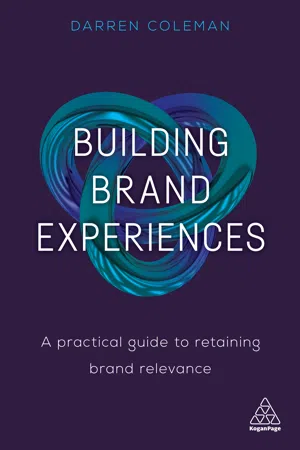
- English
- ePUB (mobile friendly)
- Available on iOS & Android
About this book
Retaining brand relevance is fundamental to organizational success, and an increasing challenge that high-level marketing professionals now face. In the past, many have responded with product or price-based competition, yet this can only propel a brand so far when it comes to retaining long-term relevance. Research shows that consumers are in fact driven by emotion and positive brand experiences have the power to drive engagement, while simultaneously offering countless options for competitive differentiation. Building Brand Experiences enables managers and executives to realize this and create tailored, relevant experiences that will appeal to consumers and drive brand performance. Practically structured around The Brand Experience Blueprint, Building Brand Experiences provides a step-by-step guide to the process of building effective brand experiences based on tried-and-tested tools, templates and informed research. Combining expert insight and real-world examples in an anecdotal and digestible way, Building Brand Experiences is the essential guide to crafting relevant experiences that consumers will love, to improve brand engagement and drive results.
Frequently asked questions
- Essential is ideal for learners and professionals who enjoy exploring a wide range of subjects. Access the Essential Library with 800,000+ trusted titles and best-sellers across business, personal growth, and the humanities. Includes unlimited reading time and Standard Read Aloud voice.
- Complete: Perfect for advanced learners and researchers needing full, unrestricted access. Unlock 1.4M+ books across hundreds of subjects, including academic and specialized titles. The Complete Plan also includes advanced features like Premium Read Aloud and Research Assistant.
Please note we cannot support devices running on iOS 13 and Android 7 or earlier. Learn more about using the app.
Information
PART ONE
Brand Experience Environment
03
Understanding your stakeholders
- profiling stakeholders;
- helping stakeholders get ‘jobs done’;
- encouraging stakeholder engagement;
- managing stakeholder expectations.
Profiling stakeholders
| Stakeholder | Type of experience you may build for this stakeholder group |
Customers (existing/prospective; B2B/B2C) |
|
Employees (existing/prospective) |
|
Suppliers |
|
Competitors |
|
Organizations you could collaborate/partner with |
|
Trade unions |
|
Governments/politicians |
|
Potential/existing investors/shareholders/ analysts |
|
Local, national or international media |
|
Local communities |
|
Lobby groups |
|
Volunteers (for charities or religious organizations) |
|
| Stakeholder | How we engage |
Investors |
|
Customers |
|
Suppliers/Business Partners |
|
Employees (current and potential) |
|
Communities |
|
Governments/Authorities/ Regulators |
|
Civil Society/NGOs |
|
Others (Media, Academics, Industry, Association) |
|
Table of contents
- Cover
- Title Page
- Copyright
- Contents
- List of Figures
- List of Tables
- About the author
- Foreword by Claire Cronin
- Acknowledgements
- 01 Introduction to retaining relevance through brand experiences
- 02 The Brand Experience Blueprint: A practical management tool
- PART ONE Brand Experience Environment
- PART TWO Brand Experience Essentials
- PART THREE Brand Experience Enablers
- PART FOUR Measuring Brand Experiences
- ‘Brand purpose’: A cautionary note
- Further reading
- Index
- Backcover